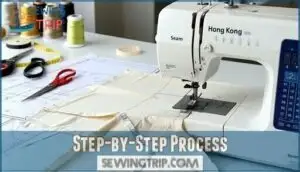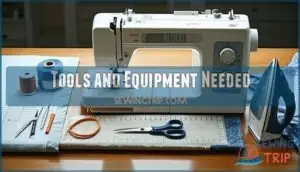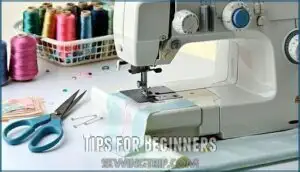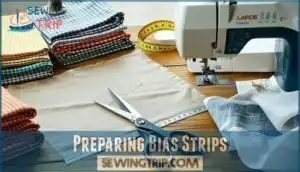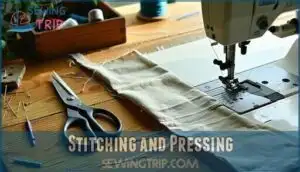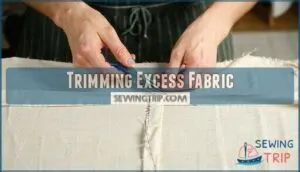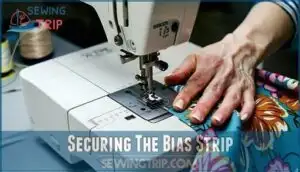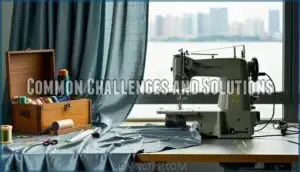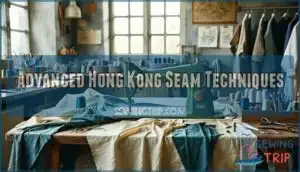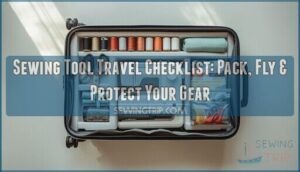This site is supported by our readers. We may earn a commission, at no cost to you, if you purchase through links.
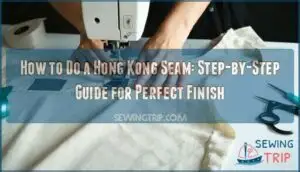
First, sew your seam and press it open. Cut bias strips from lightweight fabric, then align each strip’s edge with your seam allowance’s raw edge, right sides together.
Stitch about ¼ inch from the edge, keeping your line straight. Wrap the bias strip around the raw edge and press, then fold it over and stitch close to the fold from the right side.
This technique works like magic on unlined jackets and coats, preventing fraying while adding a polished touch. The secret lies in choosing the right bias fabric and mastering the wrapping technique.
Table Of Contents
Key Takeaways
- You’ll create professional-looking seams by pressing your seams open first, then wrapping bias strips around raw edges and stitching in the ditch to secure them
- Choose lightweight fabrics like cotton lawn or silk for your bias strips – they’ll wrap smoothly without adding bulk to your seam allowances
- Cut your bias strips 1-1.25 inches wide at a 45-degree angle to the fabric’s grain for maximum flexibility and smooth curves around seam edges
- Practice on fabric scraps before tackling your actual project – this technique requires precision stitching to achieve that couture-level finish
Hong Kong Seam Basics
You’ll discover that Hong Kong seam finishing transforms raw, fraying edges into professionally bound seams using bias fabric strips.
This technique creates a clean, durable finish that’s perfect for unlined jackets and adds a couture touch to any garment’s interior.
Definition and Purpose
Every now and then, you want your seam finishing to look as sharp on the inside as the outside.
The Hong Kong seam finish is a sewing technique where you wrap raw seam edges with bias strips for a polished, professional binding. Think of it as the secret handshake of garment construction.
- Clean edges
- No fraying
- Fabric selection freedom
- Bias bound seam durability
- Professional binding style
Benefits for Garments
Hong Kong seam finishing transforms your garment construction by delivering exceptional frayer resistance and seam durability.
Elevate your sewing with Hong Kong seams—no fraying, just strong, beautiful edges that last wash after wash.
This professional finish technique using bias tape creates superior fabric protection that extends garment longevity substantially.
Unlike raw edges that fray and weaken over time, the Hong Kong seam encases each edge completely, preventing unraveling and maintaining structural integrity through countless washes and wear cycles, which is crucial for garment longevity.
Ideal Fabrics and Materials
Lightweight fabrics work best for Hong Kong seam finishes.
Cotton fabrics like quilters cotton make excellent bias strips – they’re easy to handle and press beautifully.
Silk options add elegance to formal garments, while silk fabric creates luxurious bias tape.
For quilted jackets, choose thin materials to avoid bulk.
Your fabric selection should complement your project’s weight and style.
Understanding the seam finishing technique is essential for achieving a professional look with Hong Kong seam finishes and using the right bias strips.
Doing Hong Kong Seam
You’ll master the Hong Kong seam technique by following a straightforward process that transforms raw edges into professional-looking finishes.
This method requires basic sewing skills and creates that couture touch you see in high-end garments.
Step-by-Step Process
Master this classic finish by following three essential phases that transform raw edges into professional-quality seams.
- Seam Preparation – Press your seam allowances open flat, ensuring each side lies completely separate for accurate bias tape application and reduced bulk.
- Bias Cutting and Attachment – Cut bias tape strips 1-1.25 inches wide, then stitch them right-sides-together along each seam allowance edge using precise ¼-inch seams.
- Finishing Methods – Wrap the bias tape around raw edges, stitch in the ditch from the right side, then trim excess fabric for clean, fray-resistant results.
To achieve a professional finish, understanding seam finishing techniques is vital for garment construction.
Tools and Equipment Needed
You’ll need basic sewing machines and ironing tools to tackle this technique successfully.
Grab sharp scissors, a reliable seam ripper, and an edge stitch foot for precision work.
Cutting mats and quilting rulers help create accurate bias strips.
Your trusty iron becomes your best friend for pressing crisp seams throughout the process.
To achieve professional results, understanding basic sewing supplies is essential for selecting the right tools.
Tips for Beginners
Once you’ve got your tools ready, start practicing on fabric scraps first.
This smart move helps you nail down your stitching guide and finishing techniques before tackling your actual project.
When cutting bias tape, remember that fabric choice matters—lightweight cottons work best for beginners.
Keep your seam basics simple: press seams open, wrap the binding snugly, and stitch in the ditch.
These beginner tips will save you from unraveling disasters later, by helping you master the basics, such as cutting and stitching, and following a clear seam basics approach to achieve professional-looking results.
Preparing Bias Strips
Preparing your bias strips correctly is the foundation of a perfect Hong Kong seam finish.
You’ll need to cut fabric strips on the diagonal grain, choose lightweight materials that complement your project, and measure them precisely to match your seam allowances.
Cutting Bias Strips
Accurately cutting bias strips sets the foundation for your entire Hong Kong seam project. Think of it as prepping your canvas before painting—get this right, and everything else flows smoothly.
- Bias Strip Width: Cut strips 1 to 1.5 inches wide, with 1¼ inches being the sweet spot for most seam allowances
- Grain Direction: Always cut at a 45-degree angle to the fabric’s straight grain for maximum stretch and flexibility
- Cutting Tools: Use a rotary cutter with a quilter’s ruler on a cutting mat for precision and safety
- Strip Length: Measure your seams first, then cut continuous bias tape or individual strips to match those measurements
Using the right rotary cutting tools is essential for achieving professional results.
Choosing The Right Fabric
Your fabric selection makes or breaks your Hong Kong seam finish. Choose lightweight, stable materials like cotton lawn, batiste, or silk for bias strips.
**Your fabric choice sets the stage for seam success or disaster.
These fabrics hold crisp folds without adding bulk. For texture options, tightly woven natural fibers work best.
Consider color matching – contrasting bindings add flair to unlined garments, while matching tones prevent shadowing in lined pieces.
The Hong Kong finish technique involves using a seam finish method to achieve a professional look with crisp folds.
Measuring and Trimming
Measure your bias strips at 1 to 1.5 inches wide—think of it as your seam allowance’s best friend.
Cut strips slightly longer than your actual seam to avoid those "oops, too short" moments.
When trimming after stitching, leave about 1/8 inch beyond your seam line. This sweet spot prevents bulk while ensuring your Hong Kong seam stays put through countless washes.
Applying Hong Kong Finish
Now you’re ready to transform your prepared bias strips into a polished seam finish that’ll make the inside of your garment look as good as the outside.
This is where the magic happens – you’ll wrap, stitch, and secure each bias strip to create that signature Hong Kong look that screams professional craftsmanship.
Stitching and Pressing
With your bias strips ready, it’s time to bring everything together.
Start by folding the bias around the raw edge of your seam and pressing it firmly with your iron – this creates that crisp foundation your Hong Kong seam needs.
From the right side, use stitch techniques to sew in the ditch along the bias seam, keeping your stitching line invisible, which is a key step in creating a beautifully finished seam.
This fabric pressing step locks everything in place beautifully.
Trimming Excess Fabric
Once you’ve wrapped the bias tape around your seam allowance, trim the excess fabric to about 1/8 inch beyond the stitching line.
This fabric trimming step prevents seam bulk while maintaining enough material for a secure finish.
Use sharp fabric cutting scissors for clean edge finishing – ragged cuts can cause fraying later.
Remember, you’re aiming for precision here, not speed.
Securing The Bias Strip
Once you’ve trimmed the excess fabric, it’s time to lock everything in place.
The "stitch in the ditch" method works like magic here – you’ll sew directly in the groove where the bias strip meets the seam allowance.
This technique hides your stitches while creating a secure bias bound seam.
Your Hong Kong seam finish will stay put through countless washes, making this bias strip attachment foolproof.
Variations and Alternatives
While the classic Hong Kong seam method works beautifully, you don’t have to stick to the traditional approach if it doesn’t suit your project or skill level.
Several alternatives can give you similarly polished results, from using ready-made bias tape to exploring completely different seam finishing techniques that might work better for your specific fabric or garment style, utilizing different seam finishing techniques to achieve the desired outcome with specific fabric.
Using Store-Bought Bias Tape
Store-bought bias tape offers convenience when you’re short on time or fabric. Simply open the pre-folded tape for your first seam, then refold it around the raw edge for a clean Hong Kong seam finish.
Bias Tape Selection considerations:
- Choose tape width options that match your seam allowance thickness
- Pick bias tape colors that complement or contrast with your fabric
- Verify fabric compatibility between tape material and garment weight
- Test store bought tips like pressing before application for better results
When selecting bias tape, consider the quality of bias tape materials to achieve a professional finish.
Different Seam Finishing Techniques
While Hong Kong seam finish offers excellent results, several other finishing methods can polish your garment construction.
Each technique serves different fabric types and project needs, giving you flexibility in your sewing arsenal.
| Technique | Best For | Durability |
|---|---|---|
| Pinked Finish | Tightly woven fabrics | Low to moderate |
| Serged/Overcast | Knits and medium weights | High |
| French Seam | Lightweight, sheer fabrics | Very high |
| Flat-Felled | Heavy wovens, workwear | Extremely high |
| Bias Bound Seam | Curved seams, jackets | High |
Your fabric selection drives the finishing methods you’ll use.
Serged seams work beautifully on stretch materials, while French seams excel with delicate chiffon.
Consider seam allowances width and garment construction requirements when picking your technique.
Choosing The Right Method
Choose your seam finish based on fabric weight and garment purpose.
For delicate fabrics like silk, Hong Kong seam provides gentle edge protection without bulk.
Heavy woolens benefit from serging or zigzag stitches for durability.
Consider your skill level—bias tape offers foolproof results, while French seams require precision.
Match your technique to the fabric’s personality for professional results.
Common Challenges and Solutions
Even the neatest sewists run into tricky seams, bulky layers, or fraying edges when tackling a Hong Kong finish.
Don’t worry—you’ll learn how to handle curves, thick fabrics, and stubborn threads so your seams look sharp every time.
Working With Curved Seams
If you’ve just explored alternative seam finishes, tackling curved seams with a Hong Kong seam adds another layer of finesse.
For smooth curved edges, bias cutting is your best friend—bias tape hugs curves without puckering.
Keep your seam allowance at 3/8" to 1/2", notch or clip as needed, and gently stretch for seam stability and a couture finish.
Managing Bulk and Thickness
Two key strategies beat the bulk battle: trim your seam allowances to a consistent quarter-inch before applying the Hong Kong seam finish, and choose lightweight fabrics for your bias bound seam strips.
When dealing with seam bulk around armholes or princess seams, grade your seam allowances by cutting them at different lengths—this creates a graduated effect that reduces thickness while maintaining the professional finish you’re after.
Preventing Fraying and Unraveling
Your fabric’s wild side—fraying—needs taming for a flawless Hong Kong seam finish.
For exceptional fray prevention and seam reinforcement, try these:
- Use tightly woven bias tape for edge binding and fabric stability.
- Secure seam allowance edges with a zigzag stitch before binding.
- Double-check thread security by backstitching at each end.
Raw edge drama, solved! With these steps, you can achieve a flawless finish.
Advanced Hong Kong Seam Techniques
Once you’ve mastered the basics, it’s time to explore advanced Hong Kong seam techniques that transform ordinary garments into high-end pieces.
These professional methods using contrasting fabrics and couture finishing touches will make your sewing projects look like they came straight from a designer workshop.
Using Contrasting Fabrics
Spice up your Hong Kong seam by mixing contrasting fabrics that’ll make your garment’s interior pop.
Choose lightweight cotton lawn or silk for bias tape that won’t bulk up seam allowances.
Bold color matching or pattern mixing creates stunning visual impact, while texture contrast adds sophistication.
Your bias bound seam becomes a hidden design element that showcases personal style.
To achieve a professional finish, consider using seam finishing techniques that enhance the overall appearance of your garment, creating a stunning visual impact.
Creating a Professional Finish
Achieving professional seam quality requires precise fabric choice and painstaking finish techniques.
Your Hong Kong seam finish transforms ordinary garment details into polished workmanship that rivals high-end construction. Utilizing proper seam finishing tools is essential for a professional finish.
- Perfect tension control: Keep your bias bound seam taut but not stretched while stitching to prevent puckering or distortion in the professional finish
- Consistent seam allowances: Maintain uniform width throughout each bias tape application to guarantee your seam finish looks intentional and expertly crafted
- Strategic pressing sequence: Press each step thoroughly—first the initial seam, then the bias strip attachment, and finally the completed Hong Kong seam finish for crisp results
Adding a Couture Touch to Garments
Want to give your project that runway-ready, “I-made-this” vibe?
Using a Hong Kong seam finish with Couture Fabrics takes seam finishing to the next level.
Try a bias bound seam in a bold print for instant garment details and fashion embellishments.
This couture sewing trick makes your textile crafts look polished—think of it as secret sauce for garment construction techniques.
Frequently Asked Questions (FAQs)
How to do Hong Kong seam?
Press your seams open, wrap bias strips around raw edges, and stitch in the ditch to secure. This professional finish creates clean, fray-resistant seam allowances perfect for unlined jackets.
What is the Hong Kong lining technique?
Like a protective shield wrapping a knight’s armor, Hong Kong lining technique encases raw seam edges with bias-cut fabric strips.
You’ll bind each seam allowance separately, creating a clean, professional finish that prevents fraying while adding decorative flair to your garment’s interior.
Can Hong Kong seams work on stretch fabrics?
Yes, Hong Kong seams work on stretch fabrics, but you’ll need to handle them gently.
The bias-cut binding naturally stretches with knit fabrics, making it perfect for activewear and jersey garments that need flexibility.
How much extra fabric needed for bias strips?
You’ll need about 1/2 to 1 yard of bias fabric, depending on your garment’s seam count. Cut strips 1-5 inches wide, allowing extra for trimming and potential mistakes.
Whats the cost difference versus serging seams?
Hong Kong seam finishes cost more upfront—you’ll need bias strips and extra time—but they’re cheaper than buying a serger machine. However, serging’s faster for multiple projects.
Can you use Hong Kong finish on leather?
You can use a Hong Kong finish on leather, but it’s tricky.
Leather doesn’t press like fabric, so bias tape may not hug curves.
Try thin, flexible leather or faux leather, and use double-sided tape.
Does this technique work with very sheer fabrics?
Working with sheer fabrics requires extra care, but you’ll get beautiful results.
Choose lightweight bias tape that won’t show through, pre-test on scraps, and use a shorter stitch length for better control.
Conclusion
Practice makes perfect when learning how to do a Hong Kong seam – this professional finishing technique transforms homemade garments into couture-level pieces.
You’ve mastered the essential steps: cutting bias strips, aligning edges, stitching precisely, and wrapping carefully.
Remember that choosing lightweight fabric for your bias strips guarantees smooth results without bulk.
With patience and practice, you’ll create clean, fray-free seams that rival high-end ready-to-wear clothing every time.

